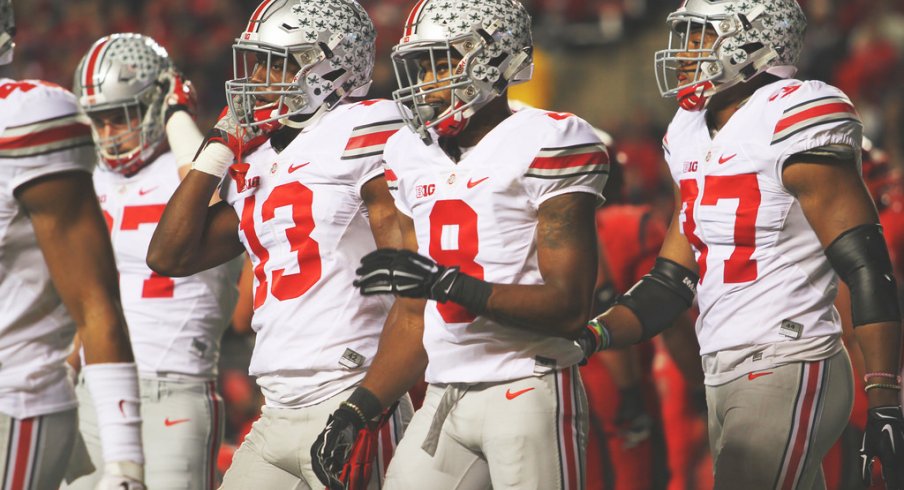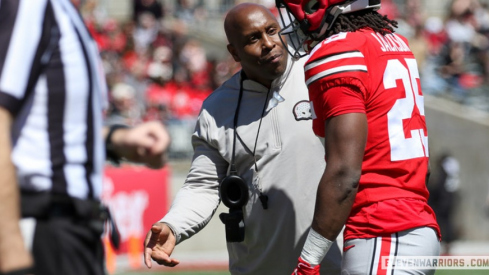"We had a lot of respect for the quarterback, the Rutgers quarterback, I think he’s one of the top efficient passers in the Big Ten and in the country," said Urban Meyer following Saturday's 49-7 win over Rutgers.
Those that watched or read the post-game interviews would think Meyer honestly felt his opponent's passing game had long been one of college football's best aerial attacks. Yet such sentiment runs counter to the game plan his defensive coaches brought to the home field of the Big Ten's eastern-most member.
Since co-coordinator Chris Ash's arrival before the 2014 season, the Buckeyes have been primarily a 'quarters' coverage team, often playing their base scheme with two deep safeties on early downs before getting more aggressive in clear passing situations. As Ash's secondary took the field on the game's opening possession, it was clear that something was very different about their attack, relying instead on a scheme often associated with perhaps the NFL's most prolific single unit.
After two straight Super Bowl appearances and multiple endorsement deals, nearly every football fan in America is familiar with Seattle Seahawks Richard Sherman, Earl Thomas, and Kam Chancellor. What separates this group from the rest of their league is not just their talent or technique, but the manner in which it's allowed to flourish.
For years, the Cover-3 defense run by Pete Carroll in the Pacific Northwest was thought of as a conservative, dated approach that could easily be taken apart by quarterbacks in the 'west-coast' offenses that took over the league in the 1990s and 2000s. Yet those defenses proved far too focused on taking away the deep ball with three deep zones, leaving the underneath zones open to the short, horizontal routes that typified the west-coast philosophy.
Upon returning to the NFL in 2010, Carroll unleashed the scheme in an entirely new manner, pressing his corners on the outside while using his safeties to create havoc all over the field. The key to 'Legion of Boom' is not scheme, but rather the talented players asked to run it. As Chancellor showed during his short hold-out earlier this season, the Seattle defense isn't the same when they lack a safety that is simply bigger and more athletic than the guys he tasked with covering or tackling.
On its face, playing Cover-3 alone isn't new or special for the Buckeyes under Ash. In fact, it's been the second-most popular coverage run since his arrival, especially on third downs. On the opening possession against Rutgers, we saw the base version as both safeties were deep, and the result was a big play.
This zone-blitz brought pressure from Darron Lee to the field while Joey Bosa released in coverage to the boundary side of the formation, asking Bell to come down in a short zone to replace Lee.

Before the ball is snapped though, we can see Apple and Conley begin to 'bail' in coverage, getting depth to stay on top of their receivers, and opening their hips to the inside while watching the quarterback instead of just the receiver. Those are two clear indicators of zone coverage, and receiver Leonte Carroo is not only able to get a free release downfield, he's able to easily turn his vertical route into a deep comeback, knowing Apple has no help behind him and is too worried about the deep ball to make a play on such a route.
Although Rutgers lined up a receiver in Carroo that almost certainly has the talent to play in the NFL, Meyer, Ash, and the Buckeyes would decide to go all-in on the same bet that Carroll does on a weekly basis, believing that in one-on-one matchups, the players in Scarlet and Gray would have the edge in talent and athleticism.
While such a bet may seem risky, it was necessary, as their opponents had made a similar decision with their philosophy. Pro-style teams like the Knights that use formations with two backs and/or two tight ends believe they can beat a team through the air sheerly by means of execution.
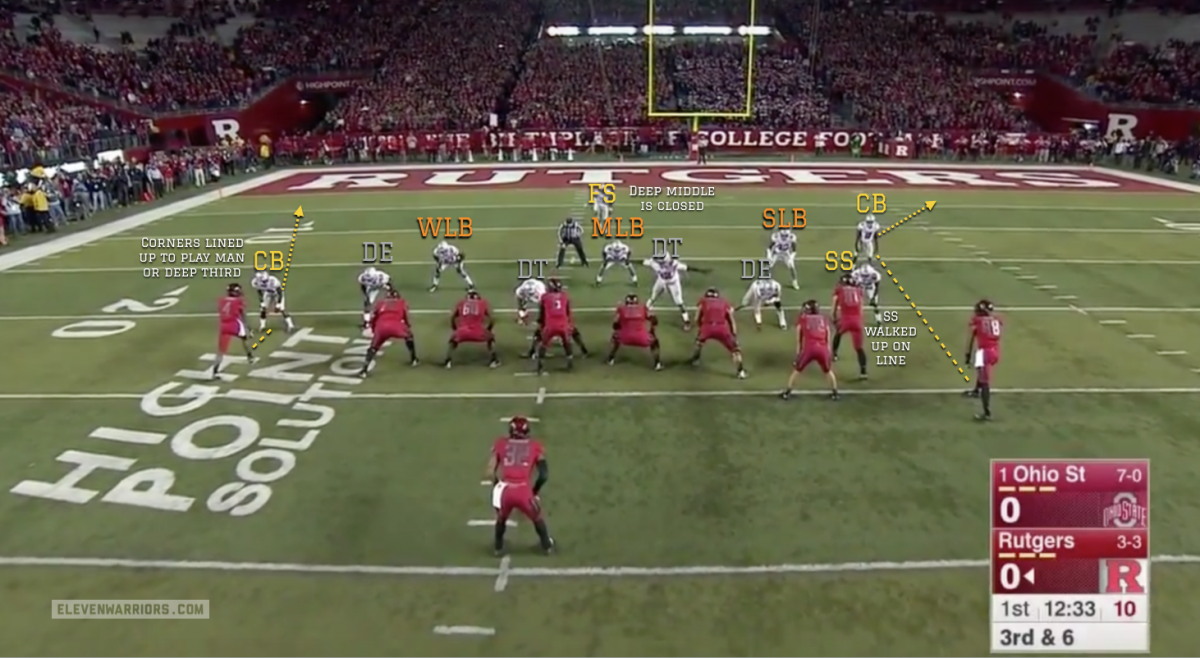
Immediately following Carroo's big gain, safety Tyvis Powell lined up on the line of scrimmage much the way an outside linebacker might, filling the role of Chancellor. Meanwhile Vonn Bell lined up deep in the middle of the field, often out the regular television camera's view, filling Thomas' spot and playing center field. With the pair lined up so far apart, it was clear that the Buckeyes wouldn't be playing their normal, 'Cover-4' scheme in which the duo each aligned on the hash marks and 10-12 yards from the line.
By leaving cornerbacks Eli Apple and Gareon Conley alone on the outside with a receiver, the Buckeyes were able to get an additional body on the line to help against the inside run with Powell. Though not known as a big hitter, Powell provides the requisite size at 6'3" and 210 lbs to withstand an oncoming block from a fullback or tight end, while also proving he can track down a ball-carrier, entering the game as the team's third-leading tackler.
For the remainder of the evening, the Buckeye secondary would play an extremely simple form of coverage. Apple and Conley would meet the outside receivers head on, often bumping Carroo at the line to throw off route-timing, then doing their best to stay in the receiver's hip pocket for the remainder of the route. All the while, Bell would follow the eyes of quarterback Chris Laviano, acting as a true safety-net for his corners who would do their best to funnel any deep routes inside towards him.
With Powell providing an eighth man in the box and shutting down the Rutgers running game to the tune of only 104 yards on 29 carries, the Knights were forced to try and get something going through the air, using crossing routes to gain separation from the aggressive OSU corners. Unfortunately, Laviano had almost no time to throw all night, showing the other half of what makes both the Seattle and Ohio State defenses so successful.

Joey Bosa continued his normal behavior by abusing the Rutgers offensive line on multiple occasions, showing why he's so coveted by NFL scouts. But even when Rutgers tried to get Laviano outside of the pocket, he was still harassed by a pass rush unencumbered with the duties of pass coverage.
With man-coverage in place, a linebacker that is responsible for a back or tight end that stays in to block is free to then rush the quarterback, as Raekwon McMillan shows here when forcing a wild throw.
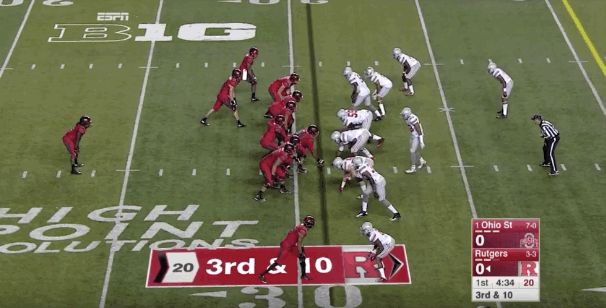
All these pieces came together beautifully in the second half when, with the Buckeyes already up big, Gareon Conley reeled in his second interception of the season. As had been the script for much of the evening, Apple and Conley were in man-to-man coverage with Bell playing deep behind them as Laviano rolled out to his right on a play-action fake.
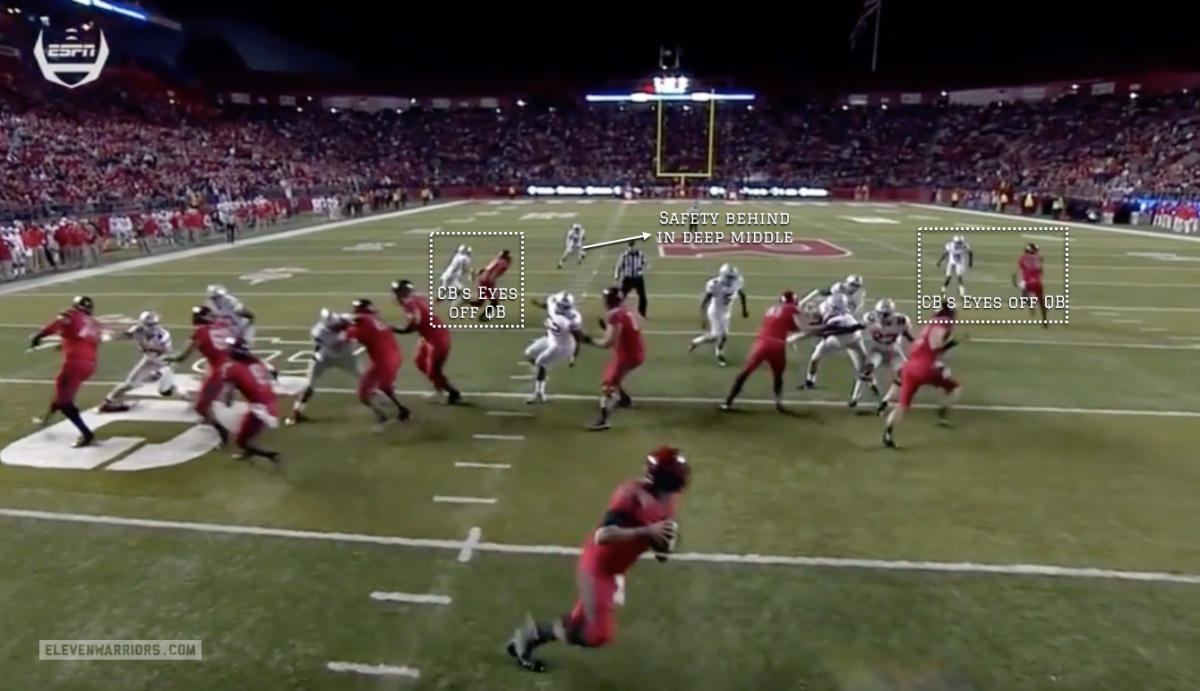
As Powell and Lee pick up the leaking tight end and fullback on this four-man 'flood' route to the right, Apple maintains great position on his crossing receiver. The only option for Laviano, and the one he looks at the whole time, is the deep out from Conley's man on the right.
The receiver gets Conley back-peddling long enough that once he breaks to the outside, he's able to gain some separation from the OSU cornerback. However, Laviano's window to get the ball there is extremely brief as defensive end Sam Hubbard closes quickly and forces an off-balance throw, which ends up behind the receiver and in the hands of Conley.

While Carroll is an anathema to Buckeye fans thanks to his successful run at USC, this isn't the first time Meyer's staff has taken something away from the former OSU assistant. Yet much like his 'Legion of Boom' has done at the next level, the Silver Bullets know that in order to repeat as champions they must play at a very high level every single week.
In many ways, this evolution of the Ohio State defense is fitting for where the program is as a whole under Meyer. After a focus on recruiting and base schemes in his first two years led to an unexpected national title run, the Buckeyes have built a program with exceptional talent on both sides of the ball.
This group long ago mastered the basic fundamentals of playing their positions, allowing the coaching staff to now focus on developing technique at a very high level. Many programs that feature star coordinators struggle when they reach this level of maturation, but Meyer has a stable of excellent teachers like Larry Johnson and Kerry Coombs in the fold who deserve just as much credit for this kind of performance as do the coordinators.
As the Buckeyes head into the bye-week with four contests remaining in the regular season, opposing coaches can't be happy at what they're seeing. Playing the Silver Bullets has graduated from a chess match to a boxing match, and the heavyweight champ is in the opposite corner. Their opponents may want to keep the towel handy.
